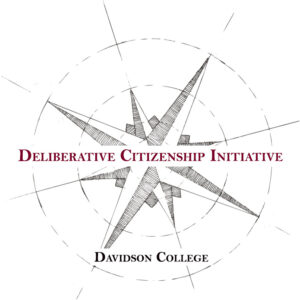
The 2021-22 cohort of the Deliberative Pedagogy (DeeP) Faculty Collaborative consists of 15 faculty from Davidson College and five other Associated Colleges of the South institutions who are committed to learning and implementing new ways to improve and deepen the quality of their class discussions. Throughout the 2021-22 academic year, these faculty, who come from a wide array of disciplines, studied and discussed different deliberative pedagogy methods, shared their ideas and questions with one another, and worked to embed deliberation in their classrooms. In this special blog series, members of the Collaborative describe and reflect on their experiences developing and teaching their deliberation-involved courses.
I warned students in my PHL 310 class at Furman University this spring that we were going to be covering some dark material. We began with an overview of liberalism. I used Michael Freeden’s Liberalism: A Very Short Introduction along with primary texts from Locke, Kant, Mill, and Rawls to define the liberal tradition—with all of its internal differences and complexities—as a philosophical paradigm that puts the dignity of the human person at its center.
We then examined a series of challenges to liberalism. We looked at Jonathan Livingstone Smith’s On Inhumanity: Dehumanization and How to Resist It, which questions whether there is a philosophical justification for human dignity and implicitly challenges liberalism as being overly optimistic about human evil. We read Kate Manne’s Down Girl: The Logic of Misogyny, which defends a pessimistic account of the prevalence of misogyny and liberalism’s failure to address it. We explored Ibram X. Kendi’s How to Be an Anti-Racist, which criticizes the “color blind” approaches to racial equality typical of some forms of liberalism. We read Jennifer M. Silva’s We’re Still Here: Pain and Politics in the Heart of America, a sociological account that depicts the rage, despair, and hopelessness of many working-class Americans, who seem to be disempowered by liberal individualism.
I intentionally planned the course to raise a number of “hot button” issues. Philosophers are lucky in that their standard approach to teaching – raising provocative questions and having students debate answers to them – already approximates democratic deliberation to some degree. But participating in the Deliberative Pedagogy Seminar encouraged me to add formal activities aimed at promoting deliberation. I devoted three 75-minute class sessions to deliberation exercises.
The first was a “fishbowl” activity. This activity involved dividing the class into two groups. The first group sat in a circle on the floor, while the second group sat at their desks in circle around them. I had the group in the inner circle deliberate about a particular issue. (The issue had to do with whether the idea of “natural human rights” was still tenable and what we ought to do to prevent horrors like genocide.) Once the first group had deliberated for a while, the students in the second group were allowed to ask clarifying questions and offer observations about the inner group’s deliberation. I then had the groups switch places and repeat the activity. Afterward, students reported that sitting close together on the floor in a “fishbowl” created a sense of intimacy and trust that made it easier for them to share their thoughts with others.
The second deliberation activity I did is called “take a position.” Using masking tape, I placed a line down the middle of the classroom. If students stood on one side of the line, that indicated that they agreed with a statement. If they stood on the other side, that indicated that they disagreed. I then read a series of controversial statements such as: “A big factor keeping poor people down in the U.S. is their over-reliance on government assistance,” “We have an obligation to help the oppressed—as long as they are not racist, sexist, homophobic, transphobic, or xenophobic,” and “The political system in the U.S. is largely deaf to the concerns of working-class Americans.” After each statement, I asked a selection of students why they ended up on the side of the line they did and why they disagreed with some of their fellow students. Students sometimes managed to persuade each other to switch sides!
The last deliberation activity I did is called “four corners.” I divided the class into four groups. In each of the four corners of the room, I taped a question to the wall addressed to the book we were reading (Kate Manne’s Down Girl: The Logic of Misogyny). Questions included whether Manne was too pessimistic about the pervasiveness and intractability of misogyny, whether she inadvertently slighted the value of caring work, whether she was correct in her claim that misogyny was to blame for the election of Donald Trump, and whether she was right to claim that young Americans were more prone to misogyny than they might care to admit. The student groups rotated from corner to corner, spending about ten minutes discussing the question at each one. Before asking the groups to move to the next corner, I would go around the room and have each group summarize their discussion – including any disagreements that arose. After each group had visited each corner, we discussed the issues raised by each question as an entire class.
Each of these three activities was useful at promoting deliberation among the students. I cannot say that I fully incorporated deliberation into the class this semester, at least not in the way I envision in my course plan. This was primarily because the material for the course was entirely new to me, and it would have been too time-consuming to completely revamp my teaching methodology. But the baby steps I took did encourage students to deliberate in a more focused way than the more “freewheeling” approach I have taken in the past. I also noticed that these more structured activities enabled some of the quieter students to feel comfortable participating. I look forward to increasing the amount of deliberative theory, pedagogy, and activities in future versions of PHL 310.
